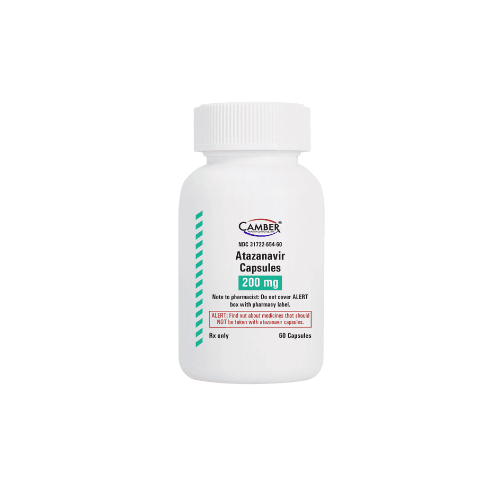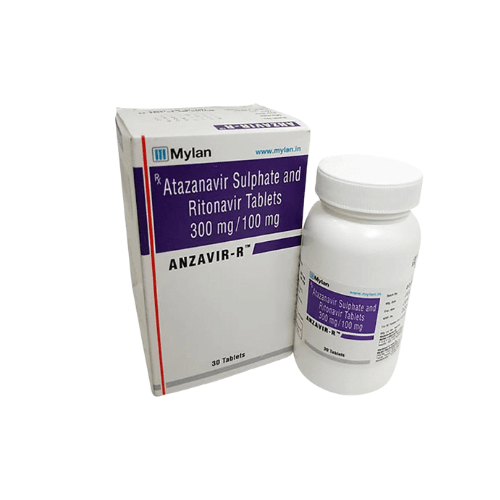Shipping with this method takes 3-5 days
Reyataz® Capsules for HIV-1
Stock up and Save - Get 20% off when you buy 3 or more of any one product. Use code SAVE20 at checkout.
Coupon code cannot be combined with other offers. Sale applies to all products originating from Canada. Maximum allowable quantity equal to a 90 day supply per single order.
Price range: $389.99 through $840.99
Secure Encrypted Payments
Atazanavir is an antiretroviral from the protease inhibitor class used for HIV-1. This page explains how the medicine works, who it may suit, and key safety points. We provide US shipping from Canada and include guidance that can help if you pay without insurance.
What Reyataz Is and How It Works
Reyataz® contains atazanavir, a protease inhibitor. It blocks the HIV-1 protease enzyme, which the virus needs to process its polyproteins into mature, infectious particles. By inhibiting this step, the treatment helps reduce viral replication. It is used with other antiretrovirals as part of a complete regimen and is typically taken once daily with food. Many patients take it with a boosting agent such as ritonavir or cobicistat, as directed by their prescriber.
YouDrugstore is a licensed Canadian pharmacy in Manitoba. Pharmacists review prescriptions before dispensing.
Acid-reducing agents can lower atazanavir absorption. Proton pump inhibitors, some H2 blockers, and antacids require careful timing or may be contraindicated depending on treatment experience. The therapy can raise bilirubin and may cause yellowing of the skin or eyes. Your healthcare professional will assess benefits and risks, review other medicines, and monitor for interactions and lab changes over time. Some people compare options under phrases like Buy Atazanavir to find clinically appropriate choices and better value.
To learn more about the condition this therapy treats, see our category page for HIV.
Who It’s For
This medicine is indicated, in combination with other antiretrovirals, for adults and eligible adolescents as directed by a prescriber. It may be considered for those starting therapy or switching regimens when appropriate. People with moderate to severe liver problems, a known hypersensitivity to any component, or those taking certain interacting drugs should avoid it.
Discuss your full medication list. Strong CYP3A inducers such as rifampin and St. John’s wort can significantly reduce atazanavir levels. Drugs that strongly rely on CYP3A for clearance, such as triazolam, oral midazolam, pimozide, and others, are generally contraindicated. Acid-reducing therapy requires careful management. If you are pregnant or planning pregnancy, your clinician will choose a regimen with the best-known safety profile for you.
Dosage and Usage
Follow your prescriber’s directions and the official label. Atazanavir is usually taken once daily with food and as part of a combination regimen. Swallow capsules whole with a beverage. Take it at the same time each day to help maintain steady levels. If you are taking acid-reducing agents, your care team will provide timing guidance.
Adults who are treatment-naive often receive 300 mg of atazanavir with 100 mg of ritonavir once daily with food. Other regimens may be used in specific circumstances. Your healthcare professional will determine whether a boosted regimen is appropriate and select companion antiretrovirals.
If a dose is vomited shortly after intake, ask your prescriber or pharmacist about next steps. Never change your dose on your own. For detailed instructions, consult the product monograph or FDA label linked below.
Strengths and Forms
Capsules are commonly available in 150 mg, 200 mg, and 300 mg strengths. Some regions also have an oral powder for select pediatric patients; availability may vary by market and supplier.
The exact selections on our site can differ by lot and manufacturer. Your order will match your prescription. If a specific strength is not listed, your prescriber may recommend an alternative or adjusted regimen supported by the label.
Missed Dose and Timing
If you miss a dose, take it when you remember if it is not close to the next scheduled time. If it is almost time for your next dose, skip the missed dose and resume your usual schedule. Do not double up to make up for a missed capsule. Because food improves absorption, try to take each dose with a meal or snack. Consistent daily timing supports adherence.
Storage and Travel Basics
Store capsules at room temperature in the original container, protected from excess moisture. Keep out of reach of children and pets. Do not transfer to a weekly pill organizer unless your pharmacist confirms it is appropriate in your setting. When traveling, carry enough medication plus a small buffer in your hand luggage and bring a copy of your prescription. If you cross borders, keep medicines in labeled containers to simplify screening. Avoid extreme heat or prolonged sunlight exposure, such as a closed car in summer.
For broader education on therapy interactions, see Drug Interactions. For public health context, review National HIV Testing.
Benefits
This medicine offers once-daily dosing with food for many adults, which can support adherence. As a protease inhibitor, it can be paired with other agents to create a potent combination regimen. Compared with some peers, it may have a different effect on lipids, though individual responses vary. The treatment has a long track record and label guidance for managing interactions. People seeking affordability may compare options under terms like Cheap Atazanavir online, but clinical suitability remains the priority.
Side Effects and Safety
- Common effects: nausea, vomiting, diarrhea, abdominal discomfort
- Changes in skin or eye color from bilirubin increase
- Headache or fatigue
- Rash or itching
Less common but serious risks include liver problems, severe rash, cardiac conduction changes (PR interval prolongation), gallstones or kidney stones, and immune reconstitution syndrome when starting combination therapy. Contact your clinician immediately for severe abdominal pain, dark urine, yellowing of the skin or eyes, fainting, or signs of an allergic reaction. The risk of low blood sugar may rise when combined with select diabetes medicines. Always review your full medical history with your prescriber.
Drug Interactions and Cautions
Atazanavir interacts with many medications through CYP3A and other pathways. Strong inducers (for example rifampin, carbamazepine, phenytoin, phenobarbital) can lower levels and reduce efficacy. Strong CYP3A substrates with narrow safety margins may be contraindicated. Acid-reducing agents can decrease absorption; antacids should be separated by time, and proton pump inhibitors or H2 blockers require label-based guidance. Certain statins, anticoagulants, benzodiazepines, and ergot derivatives need careful evaluation. Hormonal contraceptives may require alternatives.
Because regimens are individualized, your prescriber may select compatible nucleos(t)ide backbones or integrase inhibitors. For background reading on regimen choices, explore our Antivirals category.
What to Expect Over Time
With consistent dosing and a complete regimen, your clinician will monitor viral load and CD4 counts to track response. Early on, you may notice mild gastrointestinal effects or changes in bilirubin. Many effects improve as your body adjusts, though monitoring continues. Plan ahead so you do not run out; align refills with lab appointments when possible. Some people use tools like reminders and calendars to stay on schedule. To simplify ongoing access, you can Order Atazanavir online after your prescriber authorizes refills.
Compare With Alternatives
Other antiretrovirals may be considered depending on your history and lab results. Single-tablet regimens and different classes can offer convenience or fewer interactions for some patients.
- Delstrigo®: a doravirine-based tablet with two nucleoside analogs.
- Truvada®: a nucleoside backbone commonly paired with other agents.
Your prescriber will match your regimen to your resistance profile, co-medications, and clinical goals. We avoid linking the same items elsewhere to keep comparisons clear.
Pricing and Access
We list current options with transparent Canadian pricing. You can review the Atazanavir price without insurance on the product page and compare manufacturers. If you use self-pay, your clinician and pharmacist can help you balance value with clinical needs. Some shoppers review the Atazanavir cash price and look for multi-pack savings when appropriate.
We offer clear checkout and encrypted processing, with invoices for your records. For occasional coupons and sitewide offers, visit Promotions. Orders are fulfilled by our Canadian team and Ships from Canada to US after a pharmacist reviews your prescription.
Availability and Substitutions
Stock may vary by strength and supplier. If a specific presentation is unavailable, your prescriber may recommend a therapeutically appropriate alternative. Brand and generic options may differ in appearance but contain the same active ingredient when approved for substitution. If your prescription specifies no substitution, we will follow those instructions. When appropriate and with prescriber approval, patients may choose a brand or generic pathway, including options where they Order Reyataz online.
Patient Suitability and Cost-Saving Tips
This therapy may suit adults who can take a daily dose with food and follow interaction guidance. It may not suit those with significant liver disease or complex interacting regimens. If you take acid-suppressing agents, your prescriber will decide if timing adjustments allow safe co-use. Ask about multi-month fills to reduce per-ship fees and time away from work or clinic. Some patients track their Atazanavir cost per month and schedule refills ahead of travel. Consider calendar alerts, synchronized lab visits, and early refill requests to avoid gaps.
Questions to Ask Your Clinician
- Best companion drugs: Which backbone pairs safely with this protease inhibitor?
- Interaction plan: How should I time doses with antacids or H2 blockers?
- Monitoring: Which labs will you check and how often?
- Side effect support: What can I do for nausea or jaundice symptoms?
- Travel: What documents should I carry for international trips?
- Pregnancy plans: Which regimens are preferred if I become pregnant?
Authoritative Sources
Health Canada Drug Product Database
Drug Interactions and Cautions (Additional Reading)
For broader context on regimen design and safety, see these educational articles: Key Facts and Medication Uses. These resources explain how classes differ and why certain combinations are preferred.
For storage and handling questions, your pharmacist can clarify packaging, desiccants, and safe storage at home.
Ready when your prescription is? Place your order with prompt US delivery from Canada. This information is not a substitute for medical advice; always follow your prescriber’s guidance and the official label.
Express Shipping - from $25.00
Prices:
- Dry-Packed Products $25.00
- Cold-Packed Products $35.00
Shipping Countries:
- United States (all contiguous states**)
- Worldwide (excludes some countries***)
Standard Shipping - $15.00
Shipping with this method takes 5-10 days
Prices:
- Dry-Packed Products $15.00
- Not available for Cold-Packed products
Shipping Countries:
- United States (all contiguous states**)
- Worldwide (excludes some countries***)



